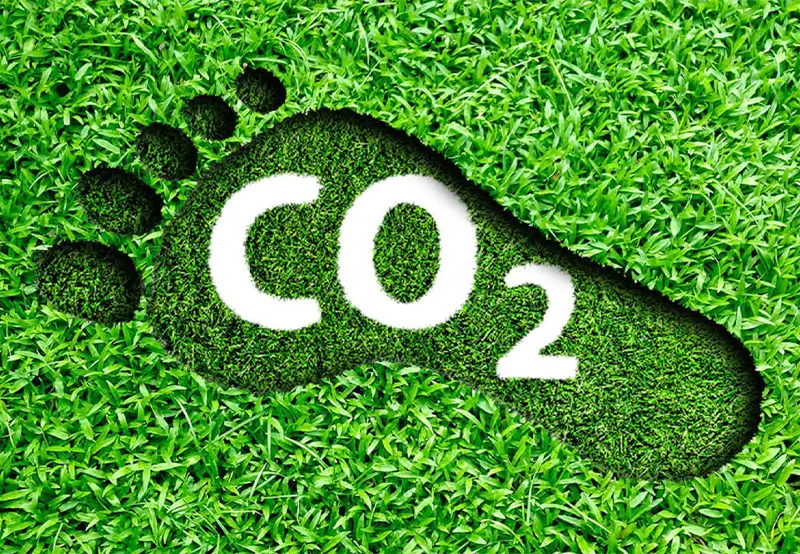Introduction
As the globe grapples with an intensifying climate crisis, never have sustainable solutions been as crucial as they are now. Adopting the use of renewable energy sources remains one of the most potent methods of decreasing carbon footprint. Solar and wind energy, hydro power, and geothermal energy are some of the sustainable alternatives that have a significant contribution to lowering carbon emissions and alleviating the negative impacts of global warming. Knowing the value of a lowering carbon footprint is a key to creating a healthier world and providing a sustainable future for future generations. Through this article, we shall discuss how renewable energy helps combat climate change and present real-life global warming solutions via clean energy.

What is Carbon Footprint?
The amount of greenhouse gases (mostly carbon dioxide (Co2)) sent to the air by human activity is the total indicator known as carbon footprint. Such releases are due to various sources such as industrial processes, transport and energy consumption. The greater the carbon footprint the more it will lead to climate change. Therefore, reducing carbon footprint is crucial in fighting global warming and maintaining ecological balance.
Why is Reducing Carbon Footprint Important?
The importance of reducing carbon footprint cannot be overstated. The high carbon emission can lead to high global temperatures, severe climatic conditions, destruction of bio diversity and poor air. Utilizing renewable energy has the possibility to lessen the carbon emissions, which will contribute to the purification of the air, improving the state of the ecosystem and enhancing the climate. Moreover, curtailment in the use of fossil fuels does away with the environmental devastation and promotes a sustainable economy.
How Renewable Energy Helps Lower Carbon Emissions
1. Solar Power: A Clean and Abundant Energy Source
Solar energy involves employment of the energy of the sun by converting sunlight to electricity with the help of the photovoltaic (PV) cells. This renewable energy source is one of the most effective ways to reduce carbon footprint because it generates electricity without emitting greenhouse gases. The other pros of solar use is that it is highly scalable hence it can be used domestically, by business and even power generating stations. In addition to the minimization of carbon emission, the investment in solar energy leads to the lower use of the non renewable resources as well.
2. Wind Energy: Harnessing Nature’s Power
Wind turbines convert wind kinetic energy into power in the form of electricity, providing a source of clean and sustainable energy. Compared to fossil fuel, wind energy is not coupled with CO2 emissions, hence it is playing an important role in reversing climate change. Further, wind farms take up minimal land area and have a relatively smaller environmental impact compared to traditional power plants, hence providing an effective alternative.
3. Hydropower: Sustainable Electricity Generation
Hydropower, or hydroelectric power, is one of the renewable energy sources that produces electricity from the power of flowing or falling water, normally from rivers or dams. It is one of the oldest and most universally applied forms of renewable energy and is useful for mitigating greenhouse gas emissions and preventing global warming. By reducing the dependence on fossil fuels, hydroelectric power offers a clean, efficient, and sustainable option that aids in environmental preservation and sustainable energy security globally.
4. Geothermal Energy: Earth’s Natural Heat
Geothermal energy harnesses the Earth’s internal heat—found beneath the surface in hot rocks, steam, and reservoirs—to generate electricity and provide direct heating. This renewable energy source is highly reliable, operating consistently regardless of weather conditions, unlike solar or wind power. It emits very low levels of greenhouse gases, making it an environmentally friendly alternative to fossil fuels. By adopting geothermal energy on a larger scale, we can significantly reduce carbon emissions while ensuring a stable, efficient, and sustainable energy supply for the future.
5. Biomass Energy: A Renewable Alternative
Biomass energy deals with transmutation of organic waste including animal and plant wastes into fuel. Compared to fossil energy, the biomass one can be referred to as carbon-neutral since the amount of CO2 that will be emitted when combusted will be compensated by the quantity of carbon that will be captured by the parabolic when in the growth phase. Biomass has the potential of being an efficient option to mitigate climate change and improve energy security in a sustainable manner.
Global Warming Solutions Through Renewable Energy
Reduction of Fossil Fuel Dependency
Fossil fuels such as oil, coal, and natural gas are the largest contributors to carbon emissions. With renewable energy sources, dependence on these harmful energy resources can be significantly reduced and the global warming rate decreased.
Enhancing Energy Efficiency
Consilience of renewable energy with energy-saving technologies is the most effective way to prevent carbon footprint. Energy-saving technologies, LED lighting, and smart home systems can also prevent the consumption of energy as well as emissions altogether.
Promoting Government Policies and Incentives
Governments all over the world are acknowledging carbon footprint minimization through adoption of policies promoting the use of clean energy. Tax credits, subsidization, and research and development investments are incentives that entice businesses and individuals to utilize clean forms of energy.
Encouraging Sustainable Transportation
Transportation is also among the major drivers of greenhouse gas emissions. Electric vehicle (EV) conversion using renewable energy, increased use of public transport and cycling and walking can curb carbon emissions.
Conclusion
Renewable energy is among the best solutions to global warming today. With a focus on clean energy sources like solar, wind, hydropower, geothermal, and biomass, it is possible to reduce carbon emissions substantially and address climate change. Reducing carbon footprint cannot be overemphasized, and embracing sustainable energy practices is crucial to securing a greener and more sustainable future. Whether through corporate initiatives, individual action, or policy reform, each movement towards the use of renewable energy advances our mission to a cleaner planet. The time to use clean energy and make a tangible difference in our environment is now.
Frequently Asked Questions (FAQs)
Renewable energy sources like solar, wind, and hydro generate electricity without releasing CO2 and other greenhouse gases. By switching to clean energy, we can significantly lower carbon emissions and mitigate climate change.
The best ways to reduce carbon footprint include using renewable energy, improving energy efficiency, adopting sustainable transportation, reducing waste, and supporting eco-friendly policies.
Lowering carbon emissions is crucial for slowing down global warming, preventing extreme weather events, protecting ecosystems, and improving air quality. Reducing emissions also promotes a sustainable and healthier future.
Individuals can contribute by using solar panels, choosing energy-efficient appliances, driving electric vehicles, recycling, reducing water waste, and supporting businesses that prioritize sustainability.
Governments play a critical role by providing incentives for renewable energy adoption, investing in sustainable infrastructure, implementing regulations to limit emissions, and raising awareness about climate change solutions.












